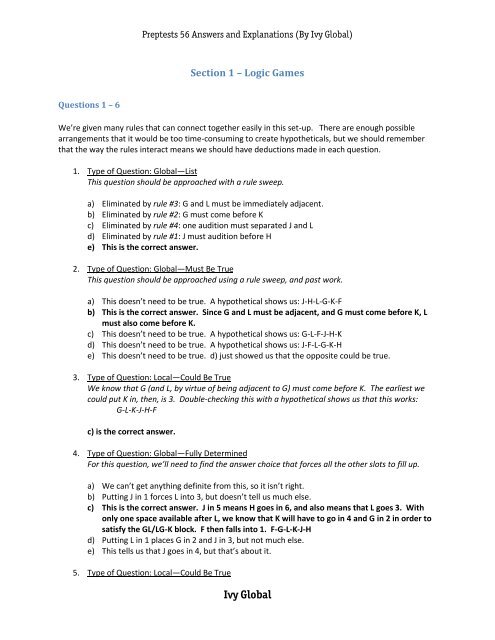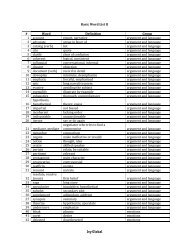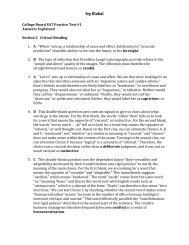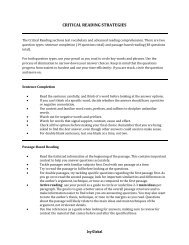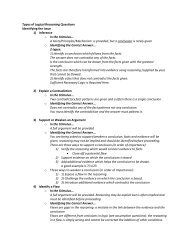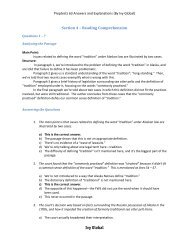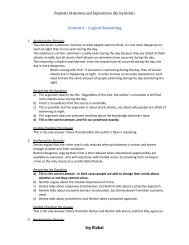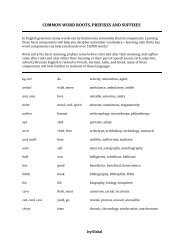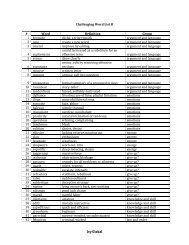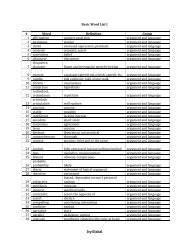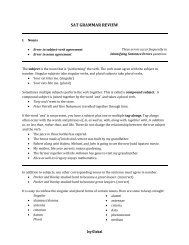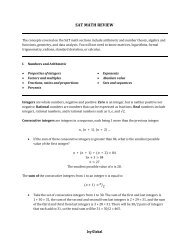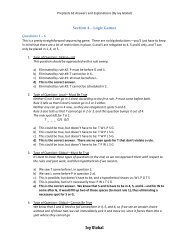Logic Games Answers - Ivy Global
Logic Games Answers - Ivy Global
Logic Games Answers - Ivy Global
You also want an ePaper? Increase the reach of your titles
YUMPU automatically turns print PDFs into web optimized ePapers that Google loves.
Preptests 56 <strong>Answers</strong> and Explanations (By <strong>Ivy</strong> <strong>Global</strong>)For this question we’ll have to jump into the answer choices, making sure that the correctanswer does NOT force F into 1.a) This is the correct answer. A hypothetical shows us that this allows for F to be somewhereother than 1: J-F-L-G-K-Hb) This pushes K into 6, and L into 4. L, in turn, pushes J into 2, which forces H into 3. The onlyspot left for F is 1: F-K-H-L-G-Kc) J has to come before H, but can’t go into 1 because then there would be nowhere to put L.So J goes into 2, and L into 4. G then gets bumped into 5 and K into 6, leaving only 1 for F:F-J-H-L-G-Kd) This bumps L into 4. We know that G needs to be connected to L, H needs to come after J,and K needs to come after G—so the empty spots 3, 5, 6 need to have G, H, and K in them.The only spot left for F is 1.e) This is the same set-up as we saw in 4 c), and it bumps F into 1: F-G-L-K-J-H6. Type of Question: <strong>Global</strong>—Must Be TrueThis question should be approached with a rule sweep and past work check.a) We saw G in 5 in 5 b), so this doesn’t have to be true: F-J-H-L-G-Kb) We saw H in 2 in 2 a), so this doesn’t have to be true: J-H-L-G-K-Fc) We saw H in 6 in 3 c), so this doesn’t have to be true: F-G-L-K-J-Hd) We saw K in 6 in 5 b), so this doesn’t have to be true: F-J-H-L-G-Ke) This is the correct answer. If we put L in 5, J goes into 3, G goes into 4, and K goes into 6,and there’s no way for H to come after J.Questions 7 – 11There are a few things to keep in mind (other than the rules, of course), in this game. The first isnumbers: in order for the numbers to work out, we’ll need to have either one person move three thingswhile the others move one each (3-1-1-1), or have two people move two things each while the othersmove one each (2-2-1-1). It’s also important to note that rule #1 is an “if, but only if” biconditionalstatement, which means that G can’t move the sofa unless H moves the recliner AND H can’t move therecliner unless G moves the sofa.7. Type of Question: <strong>Global</strong>—ListThis question should be approached with a rule sweep.a) This is the correct answer.b) Eliminated by rule # 3: G and cannot be togetherc) Eliminated by rule #2: J can only move table if M moves reclinerd) Eliminated by rule # 1: H can only move recliner if G moves sofae) Eliminated by rule #1: G can only move sofa if H moves recliner8. Type of Question: Local—Must Be TrueIf J and M move the recliner, then we know from rule #1 that G won’t be able to move the sofa,so she’ll have to move the table. She’ll do that with either M or H, since she can’t do it with J(rule #3).<strong>Ivy</strong> <strong>Global</strong>
Preptests 56 <strong>Answers</strong> and Explanations (By <strong>Ivy</strong> <strong>Global</strong>)a) This could be true, but is not necessarily so.b) This could be true, but is not necessarily so.c) This could be true, but is not necessarily so.d) This is the correct answer. The recliner is full, and she can’t move sofa unless H movesrecliner, so she’ll have to move the table.e) This could be true, but is not necessarily so.9. Type of Question: Local—Could Be TrueH moves recliner, sofa, and table. This means that G, J, and M all move only one piece offurniture each. Rule 1 requires that G move the sofa, since H is moving the recliner. The othertwo could go either way.a) She needs to move the sofa in order for H to move the recliner.b) This is the correct answer, and a possible set-up isrecliner: H, Msofa: H, Gtable: H, Jc) H and G must move the sofa.d) H and G must move the sofa.e) G can only move one thing (sofa), so she can’t move the table.10. Type of Question: <strong>Global</strong>—Could Be TrueRight off the bat we know it can’t be G and J due to rule # 3. We also know it won’t be H and G,since that would preclude us from satisfying the condition in rule # 1. We can’t have J without M,because of the stipulations in rule #2. Finally, we also can’t have H and M, since this would forceG and J together in the sofa.a) We can’t have G and J together.b) This is the correct answer and would allow for this set-up:recliner: G, Msofa: H, Jrecliner: G, Mc) We can’t have this, because it would break rule # 2.d) This would force G and J together.e) This would force us to break rule # 1.11. Type of Question: Local—Could Be TrueIf J and M move the sofa, then we know we can’t have H on recliner (since she requires G to beon sofa). H will move table. We don’t know much else and so should move to the answerchoices:a) H can’t move the recliner—she needs G on sofa for that.b) H can’t move the recliner.c) G and J can’t move anything together.d) H needs to move the table, so this doesn’t work.e) This is the correct answer, and its final product isrecliner: G, M<strong>Ivy</strong> <strong>Global</strong>
Preptests 56 <strong>Answers</strong> and Explanations (By <strong>Ivy</strong> <strong>Global</strong>)sofa: J, Mtable: H, MQuestions 12 – 16We can make a huge time-saving deduction in this game based on our rules:There are only four type of tree (M, S, O, T) and three types in each park. Since rule #3 tells usthat we can’t have O without T, and rule # 2 tells us that we need one park with M and S, weknow that only one of the parks can have O and T in it. We know for sure that the other musthave M, S, T. So there are two possibilitiesM, S, T and S/M, O, T OR M, S, T and M, S, TWe can’t be sure exactly which park is which, but if we remember that Graystone must have M,it will all fall into place once we begin.12. Type of Question: <strong>Global</strong>—ListThis question should be approached with a rule sweep.a) Eliminated by rule # 3: must have T for Ob) Eliminated by rule #2: need one park with M and Sc) Eliminated by rule # 3: must have T for Od) This is the correct answer.e) Eliminated by rule # 4: Graystone must have M13. Type of Question: <strong>Global</strong>—Must Be TrueWe’ve already made a huge deduction, and it’s likely that LSAC is going to test us on havingmade it. We’ll look for it in the answer choices.a) We can have M, O, T in Graystone with M, S, T in Landing.b) We can have S, O, T in Landing with M, S, T in Graystone.c) This is the correct answer—both parks must have T.d) We can have no S and one or two M, or one S and two M.e) This is possible, but we can also have S, O, T with M, O, T, making them equal.14. Type of Question: Local—Could Be TrueIf both parks have S, then we will have either M, S, T and M, S, T or M, S, T and S, O, T.a) This is the correct answer, and is out M, S, T and S, O, T option.b) This is not possible, since both parks have S.c) This is not possible, since we can only ever have one park with O (and we must have two Shere)d) Graystone must be M, S, T in this case (and there is no M, O, T option here)e) Landing can only be M, S, T or S, O, T.15. Type of Question: <strong>Global</strong>—Must Be FalseWe’ll need to go straight to the answer choices for this one.<strong>Ivy</strong> <strong>Global</strong>
Preptests 56 <strong>Answers</strong> and Explanations (By <strong>Ivy</strong> <strong>Global</strong>)a) This is the correct answer-- it can’t happen, since one of the parks must have M and S, andwe can’t have O without T.b) This is possible (M, S, T and M, S, T)c) This is required: we have to have T in both parks.d) This is possible (M, S, T and S, O, T)e) This is possible (M, O, T and M, S, T)16. Type of Question: <strong>Global</strong>—Could Be TrueWe’ll have to go straight to the answer choices here.a) We need T in both parks and can only have O in one (maximum.)b) We can only have O in one (maximum) park, and we must have at least one park with S.These could be equal at best.c) Both must be planted with T.d) Both must be planted with T.e) This is the correct answer. The parks could both contain M, S, T.Questions 17 – 23We can make a few minor deductions in this game, but for the most part we’ll have to play it out.Since Farm – Home, Farm can only be first or second, and Home can only be second or third.R and T cannot be first.We can either have the numbers split 1(Farm)-2-2, or 1(Farm)-1-3.17. Type of Question: <strong>Global</strong>—ListThis question should be approached with a rule sweep.a) This is the correct answer.b) Eliminated by rule #4: S cannot visit after Vc) Eliminated by rule #3: R and T must visit after Qd) Eliminated by rule #1: Farm must be after Homee) Eliminated by rule #2: Farm contains only one executive18. Type of Question: Local – Must Be TrueWe know Farm can only be in 1 or 2, and since it is only allowed to have one executive, it must bein 1 (we just filled up 2 with two). Since Q must come before R and T, it’s the only executive in 1(Farm). This leaves V and S in 3. Conversely, S R T could be in 2 with V in 3.FARM ____ ____ or FARM ____ ____Q R T V S Q R T S Va) This is the correct answer.b) This could be true, but is not necessarily so.c) This could be true, but is not necessarily so.d) This cannot be true.e) This could be true, but is not necessarily so.19. Type of Question: Local—Could Be True<strong>Ivy</strong> <strong>Global</strong>
Preptests 56 <strong>Answers</strong> and Explanations (By <strong>Ivy</strong> <strong>Global</strong>)Since Q and S will both need to come before a total of three executive in this set-up (R, T, V),they`ll need to be in the first position for either a 2-2-1 or a 3-1-1 set-up. Since Farm needs tocome before Home, and we know the “Q S” group can’t be with Farm, Farm has to be second,with Home third. This makes 1 Morn.MORN FARM HOME or MORN FARM HOMEQ S _ _ _ Q S V R/T R/Ta) This can’t be true—Farm must be in 2.b) This can’t be true—Home must be in 3.c) This is the correct answer. In the 2-1-1 set-up, we can have V as the only executive atFarm:MORN FARM HOMEQ S V R Td) This isn’t possible—S needs to be in 1.e) Farm must be in 2, and must have only one executive.20. Type of Question: <strong>Global</strong>—Cannot Be TrueThis question should be approached through past work and rule matching.a) In 21 and 23 we see that Q and V alone could visit Home.b) This is definitely possible. We’ve seen it multiple times.c) This is fine:FARM HOME MORNQ S T R Vd) This is the correct answer as it is not possible. Q needs to come before R and T, and this 3-1-1 split does not allow for that to happen (since Home cannot fall in 1).e) This works:FARM HOME MORNQ R S T V21. Type of Question: Local—Could Be TrueThe Morn- Q V combination could fall into either the first or second position (if in first, it wouldinclude S; if in second, S would be in 1 and R and T in 3).MORN FARM HOME or FARM MORN HOMEQ V S R/T R/T S Q V R Ta) This is not possible, since S must come before or with V, and R must come after Q.b) Only the first visit could include three.c) Only the first visit could include three.d) Home must be in the last position to accommodate the executives in Morn and the Farm-Home sequence.e) This is the correct answer. In the 3-1-1 example, Morn comes before Farm.22. Type of Question: <strong>Global</strong>—Must Be TrueWe’ll need to go straight to the answer choices, using rules and past work.a) We just saw Morn come before Farm in 19 and in 21, so this is not right.b) There’s nothing that suggests this needs to happen, and in 18 the opposite occurred.<strong>Ivy</strong> <strong>Global</strong>
Preptests 56 <strong>Answers</strong> and Explanations (By <strong>Ivy</strong> <strong>Global</strong>)c) In 18, we successfully placed S and V in 3, so this isn’t right.d) We saw one in 2 in 21, so this isn’t right.e) This is the correct answer. Farm needs to be in 1 or 2, so one of these will have only oneexecutive.23. Type of Question: Local—Must Be TrueNo matter what we do in this question, R and T always fall in 3. Why? Well, we know the solo Sblock will be in 1 or 2, but that means that whichever space we don’t fill has to have Q in it (sinceQ comes before R and T.) This means that the only place left for R and T (as R,T or as R, T, V) is in3.a) This is possible, but doesn’t have to be true (S- Q V- R T)b) This is the correct answer. R must be in 3.c) Q could be in Home or in Morn.d) T could be in Home or in Morn.e) Q and V could be separated (Q-S-V R T)<strong>Ivy</strong> <strong>Global</strong>


